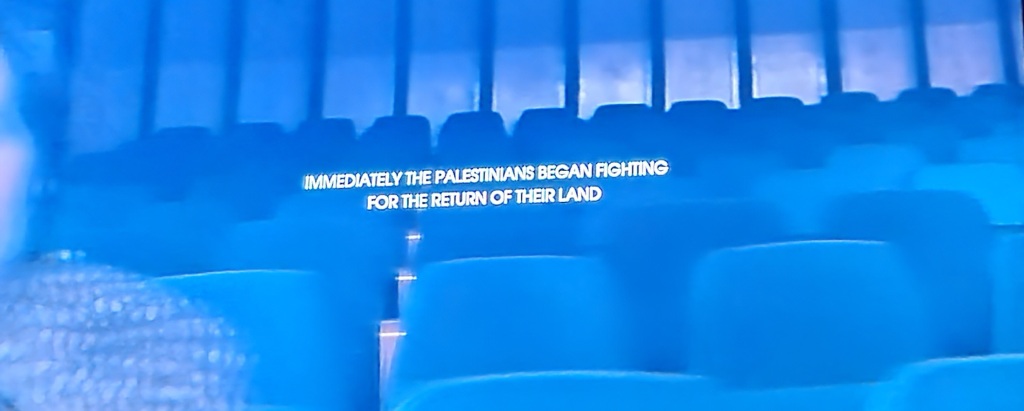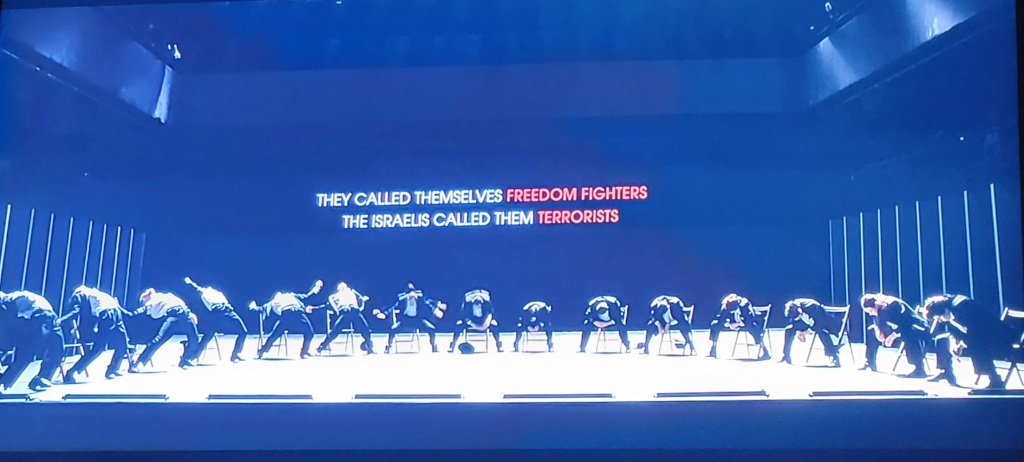Sabbath broke, so the phones turned on to check emails and the news of the prior 25 hours. The horrible reports coming out of Colleyville, Texas were not just disturbing but unsettling. Yet again, Jews were targeted by anti-Semites/ anti-Zionists to free other anti-Semites / anti-Zionists.
Between calls and community tehillim, I opted to find some strength in a historic hostage situation – when the Israeli army rescued passengers from an airplane hijacking at the Entebbe Airport in Uganda. I had seen movies relaying the exciting rescue attempts made in the 1970s, but had not seen the newer version produced in 2018 called ‘7 Days in Entebbe,’ so watched it while my thoughts were with the Jewish hostages in Texas.
It’s a very peculiar take on the story. Rather than highlight the daring rescue operation by the Israelis, the writer/ director team of Gregory Burke and Jose Padhila took a completely different approach. They told the story of two German “revolutionaries” who joined the Palestinian hijackers; explored the Israelis through the lens of a political battle between Defense Minister Shimon Peres and Prime Minister Itzhak Rabin; and littered the story with performances by the Bat Sheva Dance Company.
The Left Wing Embrace of Palestinian Terrorism
(and in a good way)
The movie opens with a distorted pro-Palestinian view of history with statements to set the background and tone of the film:
- The United Nations created Israel in 1947
- The Palestinians then fought to get their land back
- They were backed up by left-wing groups around the world
- They called themselves ‘Freedom fighters’ while the Israelis called them ‘terrorists’


The distortion needs multiple levels of unpacking.
- The UN voted to create BOTH a Jewish State and another Arab State. The Arab world refused to accept the vote as they stood firmly against any Jewish country and wanted the entire region to rule. Israel was created through its own declaration in 1948.
- The Palestinians did not have a country where they had self-determination so there was no fight for “the return of their land.” Five Arab nations waged a war against Jews who had just survived the Holocaust, to expunge the survivors from their historic homeland.
- The “left-wing” groups from the 1940s, 1970s and today have morphed in mission and focus. In the telling of this story, one senses that the writers believe that “social justice” requires actions like the taking of hostages – perhaps even today if nobody listens.
- This view was cemented by the concluding lines of how the “left-wing” viewed themselves as “freedom fighters” while the Israelis called them “terrorists.”
The “left-wing” which rallied to the Palestinians’ side, dominate the story’s focus. The movie is a platform to state how these new Germans were “not Nazis” who hated Jews like the prior generation, but fought for “social justice.” They were “humanitarians” who saw how wrong it was for the Palestinians to suffer, and therefore sought and fought for a “life of meaning,” sacrificing on behalf of others.
I think Senator Bernie Sanders may have consulted on the film.
Israeli Politicians Care About Politics, Not People
But Rabin Knew That Palestinians Deserve Negotiations
The film took a very cynical view of Israeli politicians who simply were dueling for power. While Peres may have stated that one never negotiates with terrorists, the script made clear that Peres was a political opportunist who wanted the Prime Minister to look bad so he could gain the upper hand. Even when the movie relayed how the Israeli and Jewish hostages were separated from the other passengers reminiscent of the concentration camps, there was less emotion in the scene than when a small child needed to use the restroom on the plane moments after the hijacking.
While the Israeli public was hysterical about the hostage situation, Rabin remained calm. Even after the successful rescue operation, he shared with Peres that at some point the Israelis need to talk to the Palestinians and not just fight them. The writer/director were clearly paying more attention to the future when Rabin pushed forward the Oslo Accords in the 1990s, for which he paid with his life. But it is completely ahistorical when the action happened in 1976.
The Arabs fought two wars to annihilate the Israeli Jews, in 1948-9 and in 1967. Having lost both wars of attempted genocide, they adopted the Khartoum Resolution which declared three no’s: “no peace with Israel, no recognition of Israel and no negotiations with Israel.“
The refusal to talk and make peace was a uniform Arab policy from the 1920s through that hijacking in 1976. The movie completely inverted facts and made the Israelis the party that was holding back on negotiating peace, rather than acting in a defensive capacity against neighbors determined to kill them.
Secular Israelis Have Evolved, While Traditional Jews Have Become the New Nazis
as told by the Bat Sheva Dance Company
The movie opened and closed with performances by the Israeli troupe, the Bat Sheva Dance Company. Aside from being a constant break in the flow of the movie, most movie viewers likely just found the snippets annoying and bizarre. Let me offer my take on why these scenes were in the film.
The first time we see the performance, we see a semi-circle of dancers dressed seemingly like Hasidic Jews, sitting on chairs performing before an empty auditorium. They dance to a song “Who knows one?” traditionally sung at the end of the Passover seder. Each dancer jumps in his chair except one, she falls to the ground, exposing shocking red hair. We assume at first it is a mistake, that the dancer was not supposed to fall. Or perhaps we think we understand the message since we are familiar with the Entebbe story – that one Israeli soldier dies in the rescue attempt.
I think that scene is a retelling of the Holocaust. The Jews jumping on the chairs one after the other were European Jews shot before a firing line. The one who fell to the ground was the old Jew in the ghetto, a community forever vanquished. The shock of red hair is meant as an anchor for the viewer, much like the girl in the red coat in the move “Schindler’s List.” It happens before open chairs, as to one did anything to stop the genocide of the Jews.
We see the dancers in a similar scene later in the movie. However, this time the dancers – except for the one falling with red hair – remove an article of clothing after each wave of shots. At the end, they are all standing in their underwear while the one sitting is still garbed in the Hasidic attire. This is a reflection of the new Jew which has shed religion and its past, except for a lone holdout. These are the new strong Jews who come in and shoot the hijackers. The packed auditorium loves the performance. But are these killing Jews, like a Palestinian hijacker states, the “new Nazis”?
At the very end of the film, the stage is set with only two dancers remaining. In the background is the re-haired dancer running continuously and going nowhere. In the front of the stage, the stripped down modern Jew goes from a creeper-crawler to dynamic dancer. This evolved Jew commands the stage – until abruptly exiting. We are then only left with the dull and distant Hasidic Jew, forever repeating the same actions and going nowhere.
The audience in the end is only us, the viewer, left to decide what to make of Jews: the evolving, modern, beautiful and appreciated Jew who dominates the scene and then disappears, and the traditional Jew, in the background who endures.
The failure of the movie (not just from critics and Rotten Tomatoes) is the notion of choice. The allegories of the dancers interspersed throughout the film attempt to parallel the tension and options of modern and traditional Jews with the Israeli-Arab conflict, and consequently, why secular leftists attach themselves to the Arab cause for a Palestinian state.
The orientation of the film is that Israelis and Jews have a choice as to whether to be modern or traditional, and whether to make peace with Arabs or to fight them. To set such worldview (which is perhaps a worthwhile discussion today, over a coffee) in a movie about hostages in 1976 is highly offensive and illusory. The Jewish hostages had no choice. Saving them is not an option (and certainly not simply a matter of politics). It is the Arabs who have always had the option of making peace with the Jews, and opted each time to fight.
There are two sides to a conflict, and one party may view themselves as “freedom fighters” while the other views them as “terrorists.” It is clear where you and society stood on an issue by how each party was portrayed.
The end of the Texas synagogue stand-off is a cause to celebrate. Not only were the Jewish hostages saved, but all Americans came together to clearly identify with the besieged Jews. Regrettably, that is not always the case.
The western world is fracturing when it comes to other dead and persecuted Jews, such as the recent movie retelling the story of the 1976 Israeli hostages in Entebbe from the hijackers perspective, and an opera showing the 1985 Achille Lauro cruise ship hijacking in a manner which highlighted the “humanity in the terrorists,” as general manager of the Met, Peter Gelb said about the performance “The Death of Klinghoffer“.
Will society focus on providing security to Jews or evaluate the merits of the cause of the terrorists?
Related articles:
NY Times Dislikes ‘Judaizing’ Israel
The Heartwarming Story of My Guilty Demise
The Last Sounds of “Son of Saul”
“The Death of George Floyd” Opera and The Humanity of Derek Chauvin


Pingback: The Zone Of Jew Hatred Interest | FirstOneThrough